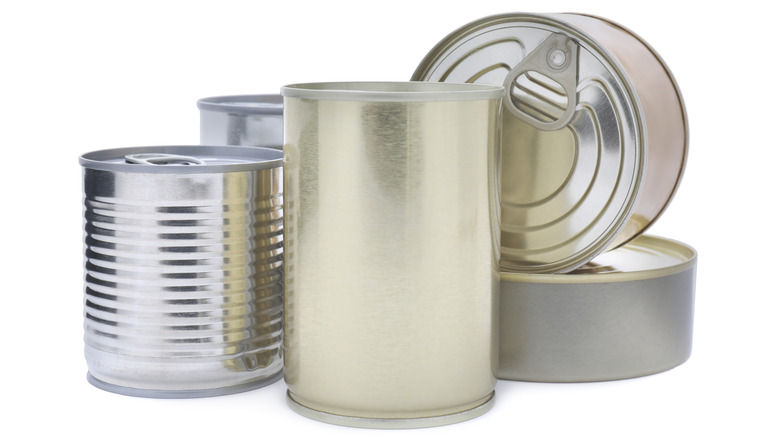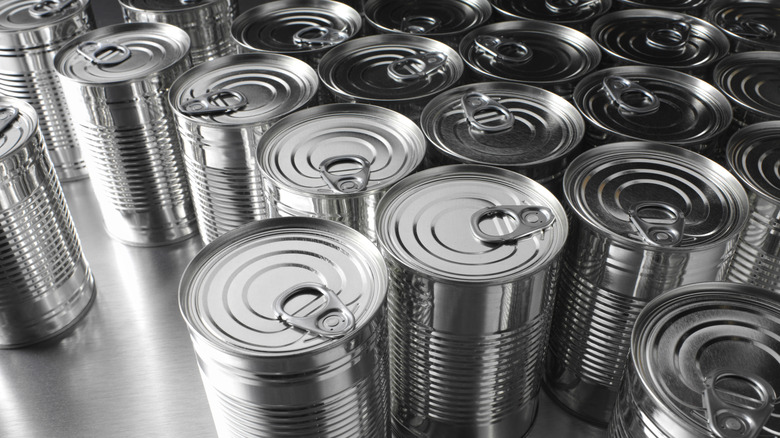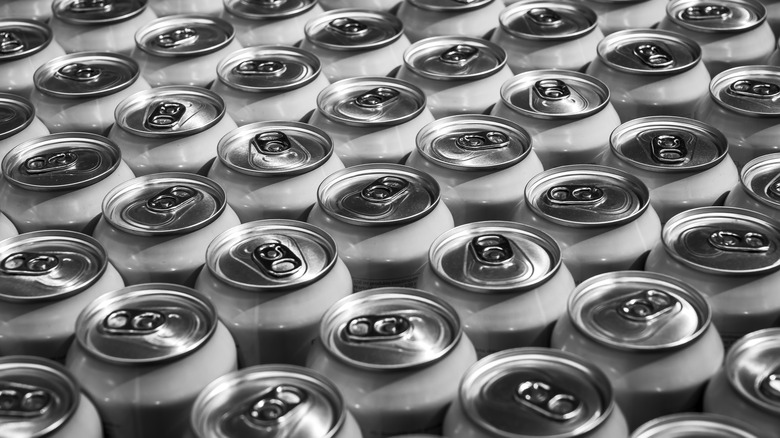The Science Behind Why Some Foods Are Canned In Tin Vs. Aluminum
Here's a little experiment to try in your pantry. Grab the first canned food you see and test it with a magnet. If the magnet sticks, it means the can you grabbed is made of tin, and if the magnet fails, it means the can is made of aluminum. Now, you're probably wondering why this difference matters. Why do we make different cans from different metals in the first place? The type of metal used to manufacture cans makes a bigger difference to food than you might think, and it's important to understand that difference if you're considering undertaking any home canning projects.
Tin cans date back to the beginning of the history of canned foods. The first can made from tin-plated iron was patented by Englishman Peter Durand in 1810, and it proved to be such a successful means of food preservation that it soon caught on in other countries. Aluminum cans are a far more recent innovation — they didn't come around until 1965.
Today, three-quarters of beverage cans are made from aluminum, but most foods continue to be canned in tin. There's a good reason for this — it's all about durability.
The pros and cons of tin cans
The term "tin can" is kind of a misnomer, as they only contain 1 to 2% tin. Tin is an extremely rare element, making up just 0.001% of the planet's crust. Thus, it's prohibitively expensive for most manufacturing purposes. The only commercial product made entirely from tin is tinfoil (not to be confused with the far more common aluminum foil).
When Peter Durand invented the first metal food can, he accounted for this high price by using tin-plated iron for his container, rather than tin alone. Eventually, the iron was replaced by tin. Today, when we use the term "tin can," we're really referring to cans made from tin-plated steel.
You might wonder why people bother adding tin to cans at all if it's so expensive, but there's a good reason for that, too. Steel and iron are strong, and they're excellent for protecting canned goods. But these metals are also highly corrosive, meaning that the canned foods could break down the can itself. This is especially true of acidic foods, such as canned tomatoes and fruits. Fortunately, tin is strongly resistant to corrosion, making it the ideal choice for lining food cans. Tin is also rust-resistant, an essential characteristic when you're storing canned goods for months or even years.
The pros and cons of aluminum cans
The biggest advantage of aluminum cans, and the reason they're so common these days, is that aluminum is extremely cheap. Aluminum is the most common metal in the Earth's crust, accounting for 8.2% of its makeup, as opposed to tin's 0.001%. However, aluminum is only naturally found in compounds with other elements, making it challenging to refine.
Nevertheless, aluminum is significantly cheaper than tin. As of the writing of this article, aluminum cost just over one dollar per pound, while tin cost nearly $12 per pound. Aluminum is also lighter than tin, making for easy transport. And aluminum cans are more efficient for recycling than tin cans.
There is a downside to aluminum's light nature, though. Aluminum cans are less sturdy than tin-plated steel cans. This explains why aluminum is preferred for beverages, which you generally only store for short-term purposes, while tin-plated steel is preferred for foods, which you may be storing for multiple years. And while aluminum is corrosion-resistant, tin holds up better to acidic foods, such as tomatoes.


